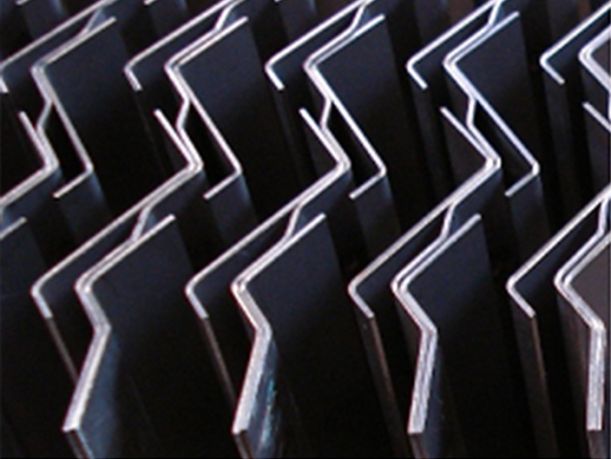Inertial forces
Inertial impaction of liquid droplets – liquid/gas separation
Inertial forces on either droplets or solid particulates can be generated by a sudden change of the fluid flow-direction. The stronger the change of direction at a given gas velocity the higher are the inertial forces attacking the droplets or solid particulates. As a result, the droplets or solids are forced to collide with a surface structure based on its inertia, from where the droplets or particulates are collected, trapped or finally drained off.
Inertial forces are especially effective, when droplets or solid particulates have a minimum mass expressed in [mg]. The density difference between the fluids also have an impact on the magnitude of the inertia.

Centrifugal forces
Separating liquid droplets and solids from continuous gas flows
The centrifugal forces are inertial forces which are directed away from a central axis of rotation. The force moves the droplets/particles to the outside to finally collide with a surface where it can be transported/drained away. Depending on the difficulty of separation, centrifugal forces equivalent of up to to several hundred G-force can be generated to finally reach the target separation efficiency.

Interception
Trapping smallest droplets with fibers
Interception is a separation mechanism that is linked to obstructions in the flow path of droplets and solids. Droplets approaching the obstacle (typically a set of fibers of a coalescer or an agglomerator) are getting collected on the surface of the fiber and trapped with other droplets. The efficiency of this mechanism largely depends on the diameter ratio of droplet and fiber and the Reynolds number. The influence of interception gets more important for smaller droplets, where inertial forces have become too small due to the low mass.
The same principle applies for solid particulates that approach droplets in a gas washer.


Surface filtration
In surface filtration the medium is used to support the captured solids which deposit onto the medium (called septum, membranes, cloth etc.) during operation.
Removal of solids is effected by the previously deposited solids or cake. As the cake builds so does the resistance to flow. Depending on the force driving the fluid through the medium (i.e. displacement pump, centrifugal pump, or just a constant liquid head above the filter) the filtrate rate can decrease and/or the pressure across the filter will increase until the filtering process is terminated.
The cake resistance is a function of the porosity and thickness of the deposit which can change with time. Filter aids are often added as a layer on the medium for additional support (called precoat) to reduce compression of the cake and impart high permeability.
